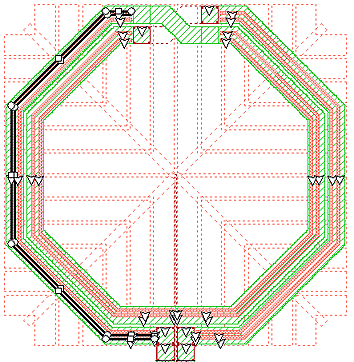Bar vias are vias whose length is significantly longer than their width. They are typically used in stacked multi-level conductors where vias carry horizontal currents. An example is shown below, with one of the bar vias highlighted in black. For vias whose aspect ratio is smaller, such as 1:1, the Sonnet model assumes that there is little to no horizontal current in the via. The assumption is that current flows in the vertical or z-direction. For bar vias, whose aspect ratio is larger, the current flow in the horizontal direction is more significant. Bar via groups placed on metal traces also drive a very fine resolution in the meshing that can require an inordinate amount of processing resources.

The Identify Bar Vias feature identifies bar vias in the translated circuit based on length to width ratio entered by the user. These vias are assigned the Bar via meshing fill, then during the analysis multiple adjacent bar vias are identified as a bar via group and merged into one wider via during the subsectioning by the analysis engine, em.
Since via arrays are simplified during translation, their appearance in the project editor is that of the simplified via polygon into which the via array was converted. However, in the case of bar vias, the actual via polygon input by the user is displayed in the project editor, because no simplification has yet been done. If you wish to see the actual metal for the simplified bar vias that are used in the simulation, you should view the subsections for the circuit.
The Simplify Via Arrays feature must be on in order to use the Identify Bar Vias feature.
This feature can be invoked inside theKeysight ADS Interface, the Cadence Virtuoso Interface, and Cadence AWR Microwave Office Interface. It may also be invoked in Sonnet’s project editor when performing an import using the Gerber/ODB++ Translator, GDSII Translator or DXF Translator.
Metal used for bar vias should always use the Volume loss model since this model supports horizontal current. Any vias that use the Array loss model or the Surface loss model will not be identified as bar vias during the simplification process.
Changes in meshing fill do not change the loss associated with a via polygon, only the way in which the via is subsectioned. Loss is based on the loss model used for the metal type. For more information about via metal types and the Volume loss model, please see Volume Loss Model. Note that this description details the loss in the vertical direction. For the horizontal loss, bar vias are modeled in the same way as Thick metal. For more information on Thick metal modeling, see the Thick Metal. For a detailed discussion of meshing fill for via polygons, please see Meshing Fill for Vias.